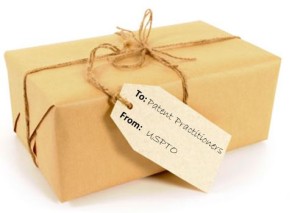PTAB Summer Package of Proposed Rule Changes Now Available and Open for Public Comment
 On March 31 we posted about the Patent Office rolling out a series of rulemakings for improving post-grant proceedings before the Patent Trial and Appeal Board (PTAB) pursuant to public feedback to a Request for Comments published by the Office last June. The first rules package went into effect this spring on May 19, 2015 and addressed “quick fixes,” such as changes to font requirements and increased page limits for petitioner replies and motions to amend.
On March 31 we posted about the Patent Office rolling out a series of rulemakings for improving post-grant proceedings before the Patent Trial and Appeal Board (PTAB) pursuant to public feedback to a Request for Comments published by the Office last June. The first rules package went into effect this spring on May 19, 2015 and addressed “quick fixes,” such as changes to font requirements and increased page limits for petitioner replies and motions to amend.
This past Wednesday, Under Secretary of Commerce for Intellectual Property and USPTO Director, Michelle Lee, announced that the Office has now published for public comment through October 19, 2015 its second rules package of proposed changes involving more substantive revisions to PTAB trial rules and the Office Patent Trial Practice Guide (Practice Guide). The proposed rule changes seek to address issues and public comments concerning the claim construction standard for PTAB trials, word count for major briefing, new testimonial evidence submitted with a patent owner preliminary response and Rule 11-type certification for all filings. The package also addresses comments relating to various general topics, including additional discovery, live testimony and confidential information, and further requests public feedback concerning future rulemaking relating to whether communications between a patent owner and U.S. patent agents and foreign patent practitioners are privileged.
The rules package contains the following proposals:
- Claim Construction: amend 37 C.F.R. §§ 42.100(b), 42.200(b) and 42.300(b) to add the phrase “that will not expire before a final written decision is issued” after “an unexpired patent”. This change would clarify that the PTAB will use a Phillips-type analysis for patents that expire during proceedings and thus cannot be amended, and confirm the use of broadest reasonable interpretation (BRI) in all other cases. According to the Office, BRI will continue to be applied because at the time a petition is filed, a patent owner’s ability to amend remains available. The Office states that allowing a patent owner to unilaterally decide to forgo claim amendments after a petition has been filed, and thereby opt-in to a Phillips-type construction, would be unworkable given the timeline of post-grant proceedings, i.e., a petitioner would not have adequate time to amend the petition to reflect a different claim construction standard.
- Word Count: amend 37 C.F.R. § 42.24 to implement a word count limitation for petitions, patent owner preliminary responses, patent owner responses and petitioner replies by substituting “14,000 words” for “60 pages” and “18,700 words” for “80 pages”. The Office indicates that petitions would no longer be reviewed to determine if claim charts contain argument, which will streamline administrative review of petitions and reduce the number of non-compliant petitions that require correction. With these changes, petitioners could present their case by including arguments in claim charts.
- Patent Owner Preliminary Responses: amend 37 C.F.R. §§ 42.107(a) and 42.207(a) to allow patent owner preliminary responses to include new testimonial evidence, such as an expert declaration. This change would address concerns that patent owners are disadvantaged by current rules that let petitioners’ evidence go unanswered before a trial is instituted. In connection with this change, 37 C.F.R. §§ 42.107(c) and 42.207(c) prohibiting use of new testimonial evidence would be deleted. The Office also proposes revising 37 C.F.R. §§ 42.108(c) and 42.208(c) to indicate that disputed material facts between petitioner and patent owner testimonial evidence will be viewed in the light most favorable to petitioner for purposes of decided whether to institute trial, and to provide that a petitioner may seek leave to file a reply to the preliminary response.
- Rule 11-Type Certification: amend 37 C.F.R. § 42.11by adding “signing papers, representations to the Board; sanctions” to its title and adding new paragraphs (b) through (d) reflecting the same. These revisions will attempt to prevent misuse during proceedings and refer misconduct to the Office of Enrollment and Discipline for investigation as warranted.
- Oral Hearing: amend 37 C.F.R. § 42.70(b) to require at least seven, not just five, days before oral argument for exchange of exhibits to provide additional time for the parties to resolve disputes concerning demonstrative exhibits.
The Office rules package also provides guidance in response to comments on various topics, including additional discovery, live testimony and confidential information:
- Additional Discovery: The Office plans to revise the Practice Guide to reflect the guidance provided by the Office on September 30, 2014 concerning the appropriate factors to consider in deciding whether to grant a request for additional discovery, as set forth in Garmin Int’l, Inc. v. Cuozzo Speed Techs. LLC, Case IPR2012-00001, at *6-7 (PTAB Mar. 5, 2013) (Paper 26).
- Live Testimony: despite requests for the Board to be more willing to permit live testimony of declarants at the oral hearing, the Office indicates that it will continue its present practice of considering motions to present live testimony at the hearing on a case-by-case basis—where a panel believes oral testimony would be helpful in making a determination, the Office will allow it. The Office also clarified that, while the definition of “trial” in 37 C.F.R. § 42.2 does not include the hearing itself and is intended to establish an endpoint for the receipt of evidence, it is understood that live testimony at the final oral hearing is evidence that becomes part of the record.
- Confidential Information: in response to various concerns regarding the disclosure of confidential information during a PTAB trial and suggestions to establish additional safeguards, the Office emphasized the importance of making information filed in an AIA proceeding open to the public, particularly because such proceeding determines the patentability of an issued patent, which affects the rights of the public. In short, the Office stated that current rules (e.g., 37 C.F.R. §§ 42.14, 42.54 and 42.56) and procedures followed and applied by the Board adequately address commenters’ concerns.

